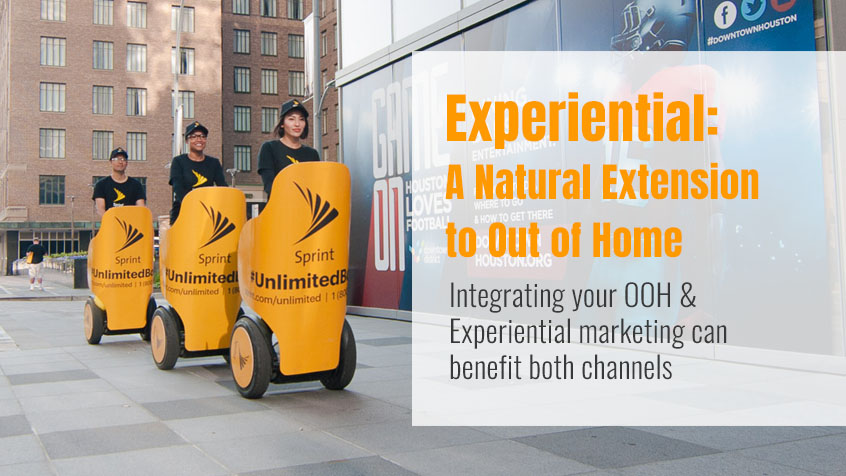How Experiential Marketing Complements Out-of-Home Advertising

Brands are constantly searching for innovative ways to cut through the clutter and create memorable experiences in today’s competitive advertising landscape. One of the most powerful combinations emerging is the integration of Experiential Marketing and Out-of-Home Advertising (OOH). Both strategies aim to create memorable experiences, but they do so in different yet complementary ways. While OOH focuses on broad exposure through billboards, transit ads, and other physical placements, experiential marketing brings consumers directly into the brand experience. When combined, they create a holistic approach that captures attention and engages on a deeper level. This article explores how Experiential Marketing enhances the effectiveness of OOH campaigns, offering a comprehensive marketing strategy for businesses.
What is Experiential Marketing?
Experiential Marketing is all about engaging consumers through immersive, interactive experiences. Instead of relying solely on traditional advertising methods, experiential marketing allows brands to create meaningful connections with their audience. These experiences can range from live events and pop-up shops to product demonstrations and virtual reality (VR) engagements. The goal is to provide a tangible interaction that emotionally connects the consumer to the brand, leaving them with lasting memories.
When paired with Out-of-Home Advertising, experiential marketing can significantly enhance a brand’s visibility and impact. OOH campaigns reach a broad audience by placing ads in high-traffic areas such as public transportation, busy streets, and shopping centers. Experiential marketing, on the other hand, amplifies this exposure by allowing people to experience the brand in a more personal and engaging way.
The Benefits of Combining Experiential Marketing and OOH
Maximizing Audience Reach
One of the key advantages of OOH advertising is its ability to reach a large and diverse audience. Billboards, posters, and digital displays are seen by thousands of people daily, making it a highly effective way to build brand awareness. However, these placements are often passive, meaning they capture attention but don’t always encourage active engagement. This is where Experiential Marketing solutions come in.
By integrating experiential elements into an OOH campaign, brands can create more interactive experiences that engage passersby. For example, a billboard advertising a new product could be paired with a nearby pop-up shop where consumers can try the product for themselves. This combination not only increases the number of people who see the ad but also deepens their connection with the brand.
Creating Memorable Experiences
OOH advertising is excellent for catching people’s attention, but it often only allows for a brief interaction. Experiential marketing takes things a step further by creating immersive, memorable experiences that resonate with consumers long after the initial interaction. When these two strategies are combined, brands can create a multi-dimensional campaign that not only captures attention but also fosters emotional engagement.
Imagine a scenario where a large digital billboard displays an exciting new beverage. Near the billboard, a branded pop-up station allows people to sample the drink, take photos, and share their experience on social media. By combining Out-of-Home Advertising with experiential marketing, the brand creates a lasting memory and generates organic buzz online, extending the reach of the campaign.
Boosting Engagement and Interaction
In today’s world, consumers crave interaction. They want to engage with brands in meaningful ways, and experiential marketing delivers just that. By adding interactive elements to an OOH campaign, brands can encourage people to engage, whether through a digital display, a live event, or a hands-on demonstration.
For instance, a billboard promoting a new smartphone could be paired with an interactive kiosk where consumers can try out the phone’s features. This not only showcases the product but also creates a direct interaction between the consumer and the brand. Combining Experiential Marketing with OOH allows businesses to turn passive viewers into active participants.
Amplifying the Impact of OOH with Digital
One of the biggest trends in advertising is the convergence of traditional and digital mediums. Both OOH and experiential marketing can leverage digital platforms to amplify their impact. For example, digital billboards can feature real-time social media feeds, encouraging users to share their experiences with a campaign. Experiential marketing can also go digital by incorporating elements like QR codes, augmented reality (AR), and live streaming.
By integrating digital tools into both OOH and experiential marketing efforts, brands can create a seamless, multi-channel experience that extends the campaign’s reach and impact. Consumers can engage with the brand both in-person and online, increasing the chances of conversion and long-term loyalty.
Enhancing Brand Loyalty
Experiential marketing thrives on emotional engagement. When consumers have a positive, memorable experience with a brand, they are more likely to develop a strong emotional connection. This translates into brand loyalty, as consumers feel more aligned with the company and its products or services.
By combining Out-of-Home Advertising with experiential tactics, brands can foster these emotional connections on a larger scale. For instance, a large-scale OOH campaign for a luxury brand can be enhanced with exclusive invite-only events, pop-up shops, or product trials. The result is a deeper, more personal relationship between the consumer and the brand, leading to increased loyalty and repeat business.
Leveraging Experiential Marketing in 2024
As we move into 2024, it’s clear that brands will need to adopt more innovative strategies to stand out in a crowded marketplace. Experiential marketing will continue to evolve, integrating new technologies such as AR, VR, and artificial intelligence (AI) to create even more immersive experiences. OOH advertising will also benefit from advancements in digital billboards, real-time data analytics, and hyper-targeted campaigns.
For businesses looking to maximize their marketing efforts, combining these two strategies offers a winning formula. By engaging consumers through both broad-reaching OOH placements and intimate, hands-on experiences, brands can create a comprehensive marketing approach that captures attention and fosters lasting connections.
Combining Experiential and OOH Marketing for Impact
In the modern advertising landscape, Experiential Marketing and Out-of-Home Advertising complement each other in powerful ways. While OOH provides the broad exposure needed to reach a large audience, experiential marketing creates personal and emotional connections that make a lasting impact. Together, these strategies offer businesses a comprehensive approach to capturing attention, engaging consumers, and building brand loyalty.
As businesses continue to navigate the challenges of the digital age, integrating Experiential Marketing solutions into their OOH campaigns will be essential for standing out and making an impact. Whether it’s through interactive billboards, pop-up shops, or immersive events, the combination of these two strategies will be key to success in 2024 and beyond. Working with a professional Out-of-Home Advertising partner can ensure that brands execute these campaigns effectively, delivering the best possible results.









